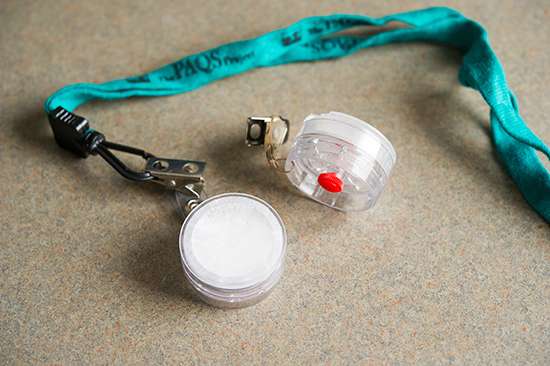Helping parents of kids with asthma to quit smoking

Adult smoking rates in the United States have declined substantially in the past 50 years, but 42 million American adults still smoke, and more than 40 percent of children are exposed to secondhand smoke. Secondhand smoke exposure (SHSe)—exposure to the smoke emitted from the end of a burning cigarette as well as the smoke exhaled by the smoker—has been linked to adverse health effects on children's respiratory health, with voluminous data showing that it increases the risk for asthma and exacerbates existing asthma. According to the Centers for Disease Control and Prevention, 6.3 million children in the US—or 8.6 percent of children under 18—suffer from asthma.
Parents who smoke cigarettes at home don't automatically connect their habit with their children's asthma, says Belinda Borrelli, a clinical psychologist and professor of health policy and health services research at Boston University's Henry M. Goldman School of Dental Medicine. "We tend to be optimistically biased," she says. "Parents think, 'If I go smoke in another room, it will be okay.' But the smoke wafts over into all the other rooms. There's the smoke and there's also the particulate matter from the smoke on the smoker's clothes. Their children's lungs are already inflamed. You hold the children against your shirt and they're breathing in particulate matter. For these kids with asthma, they're going to irritate their already-irritated bronchial tubes."
Borrelli, who is also the director of behavioral science research at the dental school, specializes in helping people who are socioeconomically disadvantaged—and who are not motivated to alter their health habits—to stop smoking. "I'm dedicated to working with the people who are at the most risk, who don't have access to effective treatments, and who are not even considering treatment," she says. She trains people in what is known as motivational interviewing, a widely accepted, evidence-based approach to behavior change that is client-centered and non-confrontational. Motivational interviewing, which grew out of efforts to help people who drink too much more than 25 years ago, focuses on strengthening a person's motivation and commitment to change.
In her latest study of parents who smoke cigarettes and have a child with asthma, Borrelli showed that combining motivational interviewing with biomarker feedback on secondhand smoke exposure improved the likelihood of smoking cessation and reduced secondhand smoke exposure. In the study, which was published in spring 2016 in the Society for the Study of Addiction's journal, Addiction, Borrelli first tested the effect of the "teachable moment"—in this case, a child's asthma exacerbation—when people might be more receptive to receiving health information. She compared parents of children with asthma to parents of non-asthmatic children who received the identical intervention. The homes of parents with children who had asthma also had significantly less smoke exposure during follow-up visits than did the homes of parents of non-asthmatic children. Borrelli was the lead author and principal investigator on the study, which she says was the first to test the effect of the teachable moment on smoking cessation.
She found that, among parents of children with asthma, those who were randomized to receive long-term telephone counseling that included motivational interviewing for smoking cessation and repeated biomarker feedback on the child's SHSe were more than twice as likely to quit smoking as compared with parents who were randomized to receive short-term counseling that included motivational interviewing for smoking cessation and only one session of biomarker feedback. Smoking cessation rates were compared at 4 months and 12 months. Parents who received the longer intervention also had children with an 81 percent lower risk of being hospitalized for asthma and who were about half as likely to miss school because of asthma. Those children were also about half as likely to have asthma symptoms over the course of the study. The study, a randomized controlled trial, included 341 parents of children with asthma and 219 parents of non-asthmatic children.
Participants in Borrelli's study did not have to be motivated to quit smoking to enroll in the trial. Most smoking cessation studies enroll only smokers who are ready to quit, Borrelli says. "Because nearly 30 percent of smokers are not ready to quit, studies that exclude them may suffer from recruitment biases," she says. In her study, parents of children with asthma were recruited from hospital emergency rooms and urgent care, where their children were treated for an asthma exacerbation. Forty percent of the parents said they were not ready to quit smoking. "We said, 'Come into this study, we'll give you some asthma education and if it's okay with you, we'll talk about smoking,'" Borrelli says. "We were using asthma education as a foot in the door to reach people who would not normally seek smoking cessation." The majority of the parents were single mothers who were unemployed, a population that is typically hard to reach for smoking cessation services, says Borrelli.

While estimates vary, for people who are motivated to quit smoking and who receive the most effective treatment—including medication and counseling—about 30 percent, maybe more, are able to stop, says Richard Saitz, a professor of community health sciences at the Boston University School of Public Health and a professor of medicine at the BU School of Medicine who is an expert on addiction. "On the other end of the spectrum, if you just give some advice and brief counseling, up to five percent will quit," Saitz says. "It's really hard to quit smoking. Most smokers want to quit; they just can't. If we get smoking behavior to change even a little bit, it's worthwhile because smoking is so horrible."
Saitz says Borrelli's study indicates that motivational interviewing—a method that Saitz trains physicians in—can help people stop smoking. "It's really hard to get people to do motivational interviewing properly," he says. "It requires substantial resources and ongoing training and supervision. The good news is that here is an intervention that can help people with a very difficult problem and that can more than double the rate of smoking cessation."
After the initial meeting with parents in the study, a counselor helped them perceive the risk of smoking to themselves by having them blow into a carbon monoxide monitor that gave them a reading. This is where client-centered motivational interviewing comes in. "We said, 'This is the same stuff that comes out of the tailpipe of your car,'" Borrelli says. "We talk about what their score is and the associated symptoms they might be having. We say, 'You said you were getting out of breath when you were running after Jason—this is why.' We don't give risk information without good news because then people get defensive. So we say the good news is what happens when you stop smoking. We tell them, 'Two weeks to three months after quitting, your breathing becomes better, your circulation improves.' People want to know: 'If I'm going to go through all this trouble, is there going to be a payoff in the end?'"
Parents were also given feedback about the risk of smoking to their children. Passive nicotine monitors were used to measure secondhand smoke exposure, a method that has been validated through numerous studies. One monitor was placed in the home for a week, in the room where the child spends the most time. The child wore a second nicotine monitor around their neck for a week.
Using gas chromatography, the nicotine levels were analyzed at the University of California at Berkeley School of Public Health, in a lab run by S. Katharine Hammond, a professor of environmental health sciences and a co-author on Borrelli's study. Each parent was given a report on the secondhand smoke exposure level in their home and its effect on their child's respiratory health.
"We'll say, 'Maria breathed in as much smoke as if she herself smoked eight cigarettes in a week,'" says Borrelli. "We'll tell them, 'The level of smoke in your home is very high—it's like the smoking section of a restaurant.'" Here, again, says Borrelli, motivational interviewing was important. "We don't want people to feel defensive, so what we do next is to give them the good news," she says. "We tell them, 'If you quit smoking, your children's asthma will get better because of reduced exposure.'"
The study underscores the need to develop novel interventions to motivate parents of non-asthmatic children to quit smoking, says Borrelli. "There is no magic pill for health behavior change," she says. "It's important to understand where the person is coming from and what's important to them and to help them see how the risky behavior is getting in the way."
More information: Belinda Borrelli et al. Motivating parents of kids with asthma to quit smoking: the effect of the teachable moment and increasing intervention intensity using a longitudinal randomized trial design, Addiction (2016). DOI: 10.1111/add.13389


















